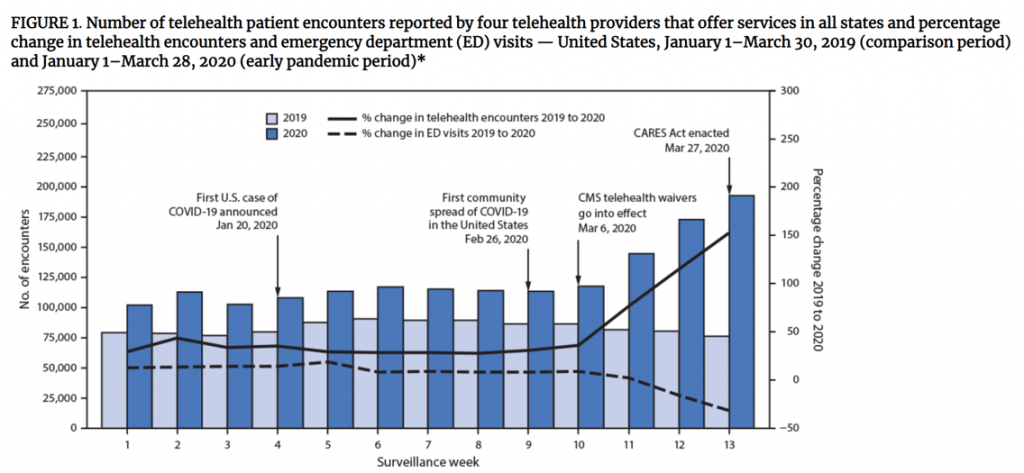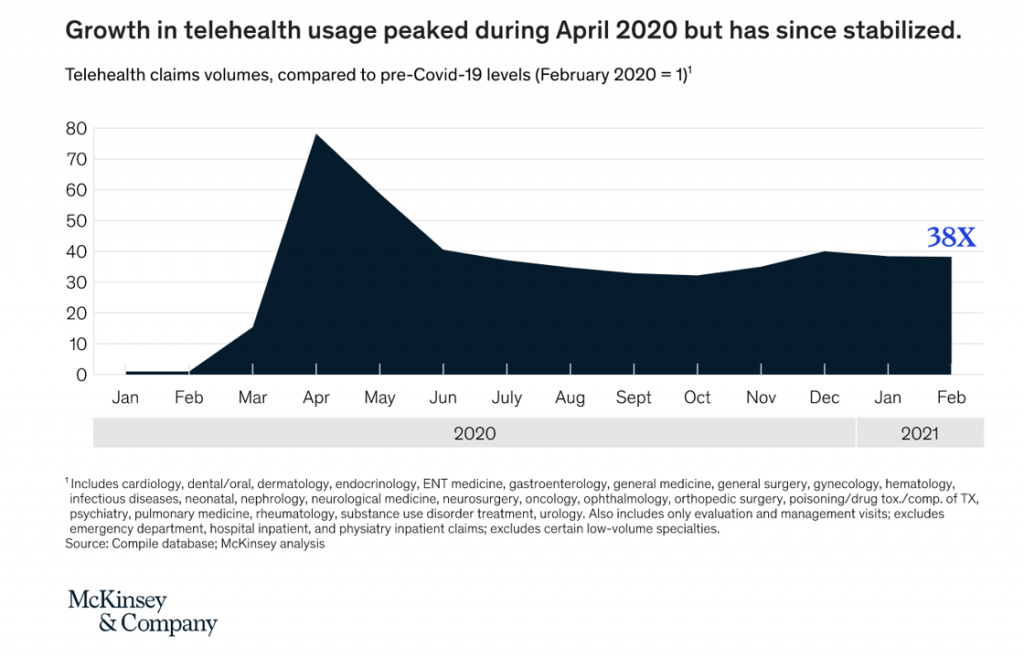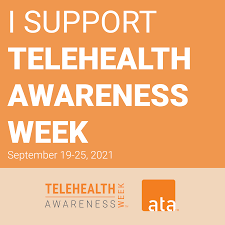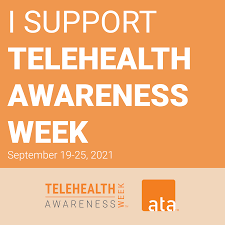 In April 2020, telemedicine morphed into mainstream medical care as hospitals and physicians risk-managed exposure to infection by meeting with patients, virtually, when possible. By March 2020, telehealth channels were replacing visits to doctors and emergency departments as shown in the first chart from the CDC’s report on the early pandemic period.
In April 2020, telemedicine morphed into mainstream medical care as hospitals and physicians risk-managed exposure to infection by meeting with patients, virtually, when possible. By March 2020, telehealth channels were replacing visits to doctors and emergency departments as shown in the first chart from the CDC’s report on the early pandemic period.
By the spring of 2021, telehealth use stabilized, but health systems had built the processes and policies to deliver on the promise of omni-channel health care — from the patient’s home and hands (via smartphones) into community sites closer-to-home, and returning to brick-and-mortar medical buildings.
 Welcome to Telehealth Awareness Week, a campaign mounted by the ATA to remind us that #TelehealthIsHealth.
Welcome to Telehealth Awareness Week, a campaign mounted by the ATA to remind us that #TelehealthIsHealth.
Beyond the sheer scale of patient volumes reached during the pandemic, virtual care was adopted by physicians across specialties well beyond primary care.
In 2020, 79% of U.S. physicians worked in a practice that used telehealth versus 25% who did so in 2018, based on a new survey from the AMA.
That study published by the American Medical Association September 15, 2021, found that by September 2020, the following specialties were using teleconferencing for patient visits:
- Dermatologists, 87.3%
- Urologists, 87.2%
- Psychiatrists, 83%
- Pediatricians, 82.9%
- Cardiologists, 82%
- Family and general practice physicians, 80.9%, and
- Internists, 76.6%.
Physicians were using telehealth for a variety of work-flows:
- 58% of practices used telehealth to diagnose or treat patients
- 59% used telehealth to manage patients with chronic disease
- 50% used telehealth to provide care to patients with acute disease
- 34% used telehealth for preventive care.
Take a closer look into the statistics on the use of telehealth to manage patients with chronic disease: endocrinologists and physicians treating diabetes were the specialty most likely to report the use of telehealth to diagnosed and treat patients, at 72% — and to manage chronic disease for 92%.
The AMA notes that, “the use of telehealth and the expanded rules around coverage and payment for it allowed physician practices to keep their revenue streams positive rather than at or near zero and to remain open to serve their patients.”
 Health Populi’s Hot Points: Gleaning the roster of founding partners for Telehealth Awareness Week gives you a sense of a Who’s Who in virtual care. It’s not just the prototypical suspects who you might expect, such as Amwell, Teladoc, and Zipnosis.
Health Populi’s Hot Points: Gleaning the roster of founding partners for Telehealth Awareness Week gives you a sense of a Who’s Who in virtual care. It’s not just the prototypical suspects who you might expect, such as Amwell, Teladoc, and Zipnosis.
You’ll find Best Buy Health here, 1-800-Contacts, and Hims, for example. Their core businesses cover, respectively,
- Retail consumer electronics
- Vision care, and
- Hims.
Wikipedia will tell you that Hims’ “initially sold erectile dysfunction treatment sildenafil and hair loss treatments such as minoxidil, biotin vitamins and DHT-blocking shampoo.”
Last week during New York Fashion Week, Hims’ announced an alliance with REVOLVE, the ecommerce fashion retailer, to channel health and wellness products to fashion-minded shoppers.
Health and wellness are expanding in the retail health, closer-to-patients’-homes ecosystem of care. Note that Hy-Vee, the grocery chain, is in process of growing its own health/care continuum and portfolio of services, from food-as-medicine to specialty drugs, vision care, and fitness equipment in the store. You can even buy a pair of fitness sneakers in a co-located DSW shoe department located not far from the frozen food section. Hy-Vee also introduced a Medicare Aisle into its grocery stores in August 2021. And the grocer is expanding its pharmacy footprint, having piloted tele-pharmacy back in 2017.
 If you believe in the power of virtual care, you can learn more and promote on social media using the hashtag #TelehealthAware.
If you believe in the power of virtual care, you can learn more and promote on social media using the hashtag #TelehealthAware.





 Thank you FeedSpot for
Thank you FeedSpot for